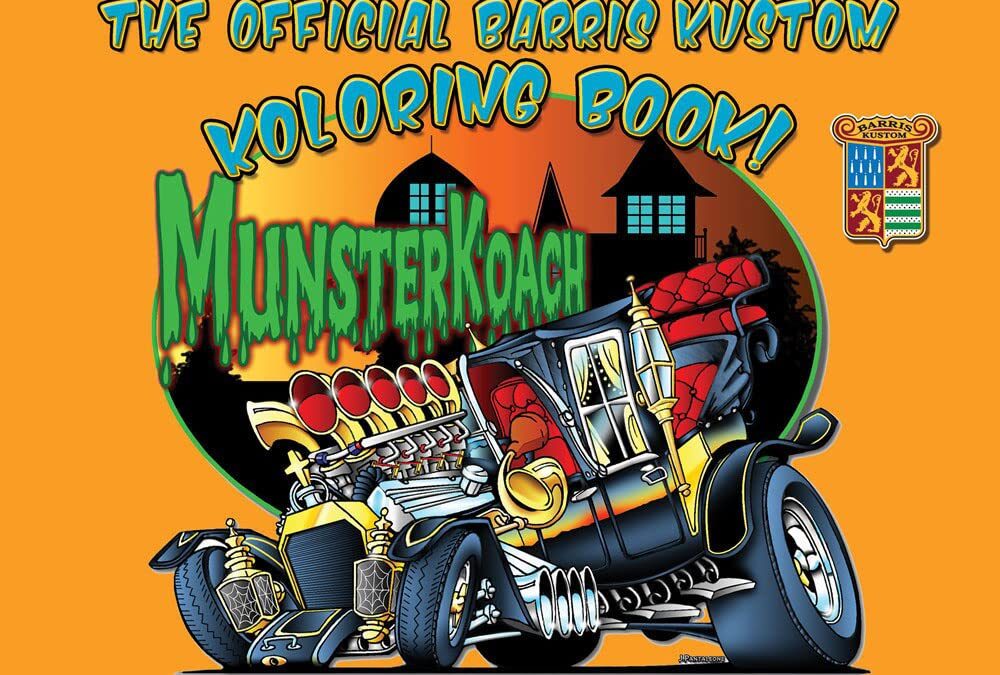
Have fun koloring these famous Barris Kustoms with illustrations by some of the top artists in the industry!
A collection of 26 illustrations of select cars, the design styles range from lowbrow to semi-realistic. Each image reflects the Barris Kustoms style and honors what George, Sam and Barris Kustoms were all about.
Add your own paint job to these unique vehicles:
Kopper Kart – Sam’s Merc – Emperor – Ala Kart – Silver Sapphire – Golden Sahara – Vox Mobile – Moonscope – Turbo Sonic – XPAC 400 – Beverly Hillbillies – Drag-u-la – Munster Koach – The CAR – Elvira Macabre Mobile – Red Foxx Wrecker – ZZR – Calico Surfer – Surf Hearse – Ice Cream Truck – Mail Truck – Alvin’s Acorn – Hirohata Merc
George Barris is undisputably the “King of the Kustomizers,” the most phenomenal kustom car builder ever. Barris created some of the best known and iconic cars of the 20th century, inlcuding the original TV Batmobile, the Munsters Koach, Hirohata Merc, Ala Kart and countless other made-to-order vehicles for movies, TV, and for the private use of his celebrity clients.
Art by Vince Ray, Dennis McPhail, Jeff Allison, Johnny Ace, Mike Bell, Shawn Dickinson, and Stephen Sandoval!
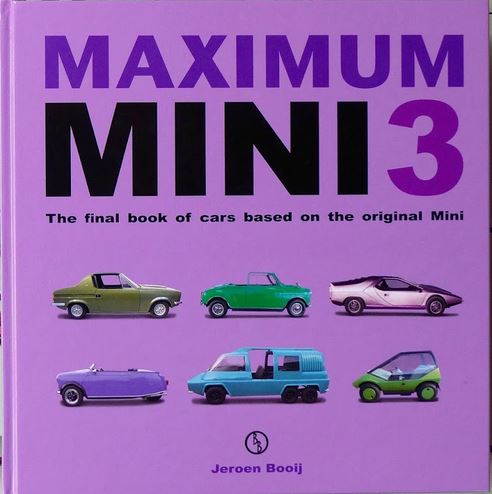
The final book in the Maximum Mini series, already now referred to as the Mini’s ‘Trilogy of Terrors’…
So, what to expect?
Another 128 pages full of Mini based cars, in a hardback similar in size and lay-out as the first two volumes. Yes. But that’s where the similarities end. This one is quite different from what you have seen before.
Where all of the known and slightly lesser known cars were covered in detail over a two-page spread each in the first two books, this one features a lot more of them. 397 More Mini derivatives to be precise. Yes. 397. It has become a bit of an encyclopedia of obscurities and you’ll be surprised to find out what else the Mini’s multipurpose mechanicals brought forth. Trikes, twinis, racers, coachbuilt specials, beach cars, buggies, jeeps and a dragster, oh yes. But there are also also Mini powered fire engines, crop sprayers, ice cream vans, camper vans, motorkhana specials, miniature buses and wacky marketing mobiles. There is a Wood & Pickett trimmed four-door Mini which did the grueling 16,000-mile World Cup Rally in 1970 and a three-wheeler that was designed and built by the chief stylist of Rolls-Royce and Bentley in his spare time. There are Mini Moke based movie vehicles from Moonraker and UFO, The Persuaders and The Prisoner.
Apart from the UK the vehicles featured in this book originate from Ireland, the US, Canada, Australia, New Zealand, Scotland, Germany, Malta, Japan, Italy, France, Greece, Portugal, South-Africa, Belgium, The Netherlands, Spain, Barbados, Denmark, Uruguay, Chile and Switzerland.
limited edition of 600 numbered pieces
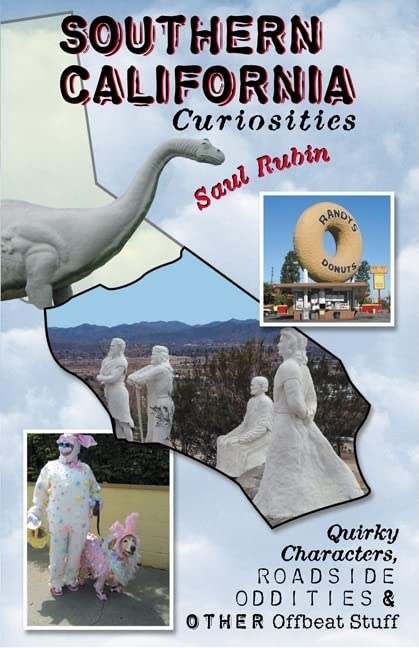
Welcome to Southern California, where residents take their pooches out for ice cream at the Hydrant Café, attend an annual Blessing of the Cars, and then climb aboard a hearse for a Grave Line Tour to find out how, when, where, and sometimes why Hollywood’s finest died. If you’re a sports fan, visit the Baseball Reliquary, home to a partially smoked cigar of Babe Ruth, a fragment of skin from the inner left thigh of baseball pioneer Abner Doubleday, and the gold-plated shovel used by Angels owner Gene Autry during groundbreaking ceremonies at Anaheim Stadium in 1964. And don’t forget the world’s largest champagne glass, still bubbling away at the Lawrence Welk Museum. With this book in hand, readers will be sure to laugh as they learn what lies way off the beaten path in this part of the Golden State.
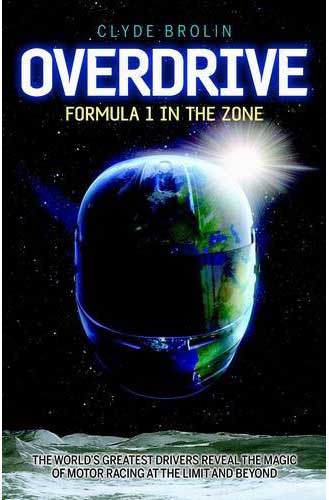
Listed in the Daily Telegraph’s top ten sports books of 2010, Overdrive draws on exclusive interviews with 100 of the world’s quickest men – from Stirling Moss through to Sebastian Vettel, Fernando Alonso, Michael Schumacher and Lewis Hamilton – to reveal the magic of motor racing at the limit and beyond. Ayrton Senna once famously crushed the F1 field at Monaco while in an apparent trance, an experience that led him to a spiritual rebirth. Overdrive reveals the grand prix greats have all shared aspects of Senna’s epiphany at their finest hours. To ride on a thousand screaming horses may seem an unlikely source of inner peace but life at 200mph can lead to surreal effects from slow motion to journeys out of the body. Stars of other sports confirm this mystical ‘Zone’ is accessible in any field but in motor racing only the masters tame it, bending time and space as they speed to Earthly laps of the gods. Overdrive is the first book to look deep inside their crash helmets and tell the story of how they do it. Damien Smith (Motor Sport) ‘Brolin risked being laughed at when asking drivers including Alonso, Schumacher and Hamilton if they have experienced out-of-body sensations. Instead, they were happy to oblige. The most original motor racing book of 2010? Without a doubt.’ Simon Briggs (Daily Telegraph) ‘The product of ten years labour, Overdrive is insightful and leaves you with a fresh perspective on F1 – exactly what Senna experienced in Monaco all those years ago.’ Julie Gueguen (FOFA) ‘Far from alpha males fighting it out, Overdrive pictures racers as profoundly human, sometimes mystical men. All agree the perfect lap justifies the years of sacrifice. Not the champagne…’ Laurence Edmondson (ESPNF1) ‘Overdrive leaves you looking at sport’s greatest achievements in a different light. The content is incredibly fresh and brilliant descriptions include darts player Bobby George: ‘Like a thousand starlings flying out of your a*******…’ Dan Cross (Motorsport Musings) ‘Fascinating as it is thought-provoking, Overdrive is no ordinary sports book. It has clearly been a labour of love for the author and his passion for the subject shines through on every page.’
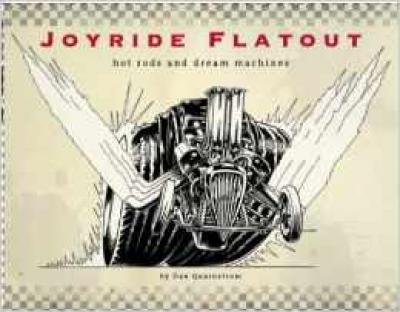
In Joyride Flatout, Dan Quarnstrom revisits the territory that originally inspired him, taught him to draw for the sheer fun of it and to recognize the opportunities he was presented with. Before he had a career, and throughout the one he has persued, he’s been completely nuts about Hot Rods. This book is the manifestation of that obsession.
JOYRIDE – in its simplest incarnation a joyride can be as innocent as taking the family car out for a spin. Perhaps taking mom’s station wagon or dad’s sedan to an empty stretch of road and opening them up for some velocity challenged friends.
More elaborate schemes to fulfill the need for speed include “borrowing” a stranger’s car and returning it a few hours later, albeit with the addition of a few extra miles on the odometer and a lot less rubber on the tires.
In an effort to quench this primal desire, rational men will drop big block Chrysler motors into tiny Fiat bodies and smoke their way down a quarter mile of asphalt. In belching fire and screaming noise, dreams are made real, and so it is on the printed page.
To Joyride is to recapture the sense of what is possible. The exhilaration of ideas well executed, barriers being broken, the collision of the sublime and the ridiculous.
If JOYRIDE is inspiration, then FLATOUT is intensity.
The artwork in this book is the continuation of Quarnstrom’s lifelong fascination with hot rods, dragsters and custom cars, currently called Joyride Flatout. As the source of his earliest inspiration and having provided him with the raw materials for a lifetime of drawing, he revisits this subject matter often. These are the drawings he wanted to do when he was 12 years old, but didn’t have the skills to pull them off (some are drawings done when he was 12).
The pioneers of wild style car design, Ed “Big Daddy” Roth and his contemporaries, were at the height of their powers as custom car designers, providing a panorama of challenges for thousands of aspiring pencil jockeys. They provoked, validated and sustained his interest in the mechanical as art.
On the other side of the fence the drag racers were creating some of the most aesthetically pleasing, murderously loud, fire breathing beasts imaginable. More characters than cars, machines had been transformed into something beyond our comprehension. They made quite a lasting impression.
The concepts Dan Quarnstrom internalized then about design, attitude, character, shape, volume, weight, mechanics, precision and patience, he now uses professionally, on a daily basis. More importantly the real lesson was the enticement, the challenge, to think unconventionally, to color wildly outside the lines. It was a conspiracy of fun.
This is a book about finding inspiration and holding on to it.
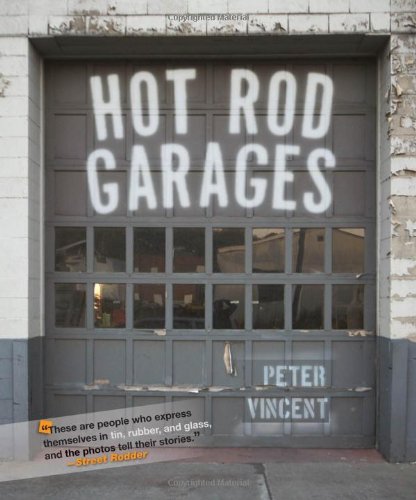
In Hot Rod Garages, acclaimed hot rod photographer and author Peter Vincent gives readers an intimate look inside the shops and garages of more than two dozen rod and custom builders. Unlike most hot rod books, Vincent’s takes a strictly California-centric approach in examining shops across the United States. From individuals crafting cars for their own reward to more prominent builders turning out cool rides for paying customers, Vincent and his cameras show the builders in the context of their spaces, in the process exploring how their work environments inform their creations and vice versa. Included are individuals like Pete Eastwood who have garnered attention in the hot rod press while building mostly for themselves; builders like Vern and Keith Tardel, the Kennedy Brothers, and Cole Foster with his crew at Salinas Boyz, all currently being celebrated for the traditionally styled rides they build for consumers; and high-end shops widely considered to be the cream of the industry, like Roy Brizio’s and Steve Moal’s in the Bay Area, as well as SO-CAL Speed Shop (heir to legend Alex Xydias). The result is the next best thing to being there—an exquisitely presented book that eloquently distills the varying nature of these spaces and the cars created within, revealing the countless hours spent machining, wrenching, welding, and shaping these beautiful visions to fruition.

” Around the Circuit is a sequel to the author’s previous, award-winning work entitled Inside the Paddock – Racing Car Transporters at Work. This new book not only includes further recently-found images of transporters but also team support vehicles, breakdown trucks, oil, tyre and other sponsors’ vehicles, safety and medical cars, fire appliances, ambulances, ice cream vans and even bicycles and quad-bikes for individual paddock transport.
Overshadowed by the antics of racing drivers and their magnificent steeds, little has been written about racing car transporters and support vehicles. However, they are vital ingredients of all racing events and these 600 photographs and other images fill a glaring gap in the chronicles of motor sport.
”
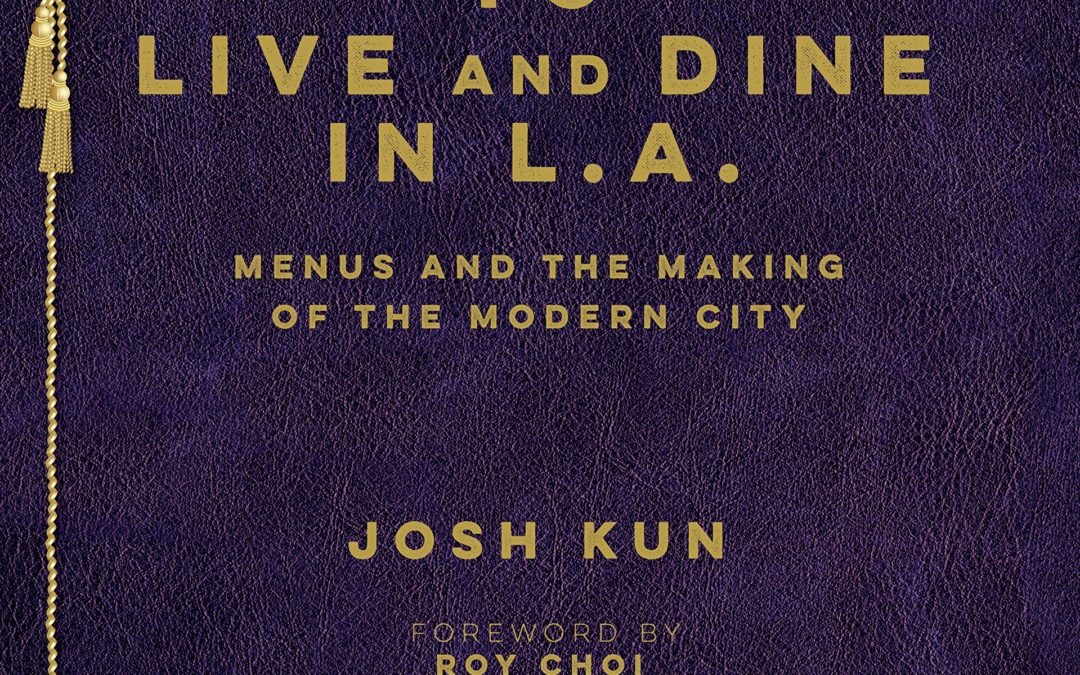
How did Los Angeles become the modern city the world watches? We know some of the answers all too well. Sunshine. Railroads. Hollywood. Freeways. But there’s another often overlooked but especially delicious and revealing factor: food.
Think veggie tacos and designer pizzas, hot dogs on sticks and burgers from golden arches, Cobb Salads and chocolate-topped ice cream sundaes, not to mention the healthiest dishes on the planet. Ask anyone who has eaten in L.A.–the city shapes the tastes that predict how America eats. And it always has.
In its fourth book collaboration with the Los Angeles Public Library and the Library Foundation of Los Angeles, Angel City Press releases To Live and Dine in L.A.: Menus and the Making of the Modern City by Josh Kun.With more than 200 menus–some dating back to the nineteenth century–culled from thousands in the Menu Collection of the Los Angeles Public Library, To Live and Dine in L.A. is a visual feast of a book.
But it’s more. Much more.
In his detailed history, author Josh Kun riffs on what the food of a foodie city says about place and time; how some people eat big while others go hungry, and what that says about the past and now. Kun turns to chefs and cultural observers for their take on modern: Chef Roy Choi sits down long enough to say why he writes “some weird-ass menus.” Pulitzer Prize-winning critic Jonathan Gold looks at food as theater, and museum curator Staci Steinberger considers the design of classic menus like Lawry’s. Restaurateur Bricia Lopez follows a Oaxacan menu into the heart of Koreatown.
The city’s leading chefs remix vintage menus with a 21st-century spin: Joachim Splichal, Nancy Silverton, Susan Feniger, Ricardo Diaz, Jazz Singsanong, Cynthia Hawkins, Micah Wexler, Ramiro Arvizu and Jaime Martin del Campo cook up the past with new flavors. And, of course, the menus delight: Tick Tock Tea Room, Brown Derby, Trumps, Slapsy Maxie’s, Don the Beachcomber, and scores more.
Kun tackles the timely and critically important topic of food justice, and shows how vintage menus teach us about more than just what’s tasty, and serve as guides to the politics, economics, and sociology of eating.
America is a dining-out nation, and our research indicates that L.A. has long been one of its top dining-out towns. The Library’s collection is a living repository of meals past, an archive of urban eating that tells us about the changing historical role of food in the city, which is to say it tells us about just about everything that food touches: economics, culture, taste, race, politics, architecture, class, design, industry, gender, to name just some of the themes that recur on menu pages.
Kun challenged contributors to tackle subjects that readers may have never contemplated. As the renowned L.A. chef Roy Choi points out in his Foreword to To Live and Dine in L.A.:
The more I looked at the menus, the more they told me about the city and how neighborhoods developed. But it was the menus that I couldn’t find that forced me to ask questions about how life really was. I started to think about how the city is now and if those missing menus were a reflection of life just as it is now. Were these menus of the affluent and middle-class? Were the working classes even eating with menus, or were they mostly eating at stands and carts? Were there disparities and access problems just like today? To Live and Dine in L.A. is the first book of its kind–the definitive way to read a menu for more than just what to order. It’s about how to live. And how to dine. In L.A.










